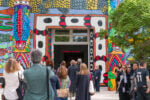Predatory behavior
.jpg)
Mostra collettiva ‘Predatory behavior’.
Comunicato stampa
Predatory behavior
Julie Curtiss, Petrit Halilaj, Lin May Saeed, Virginia Russolo, Lorenzo Scotto di Luzio, Sophie Vallance
22 June – 28 July, 2018
Opening 21 June at 6pm
T293, Via Ripense 6, Rome
www.t293.it
[email protected]
Madre Natura, Madre Terra, Grande Madre: la storia delle civiltà del pianeta, sia presenti che passate, è impregnata di miti, leggende e riti che riconoscono alla donna il ruolo fondamentale di procreatrice e quella forte componente vitale che lega la sua figura a tutte le espressioni più naturali in maniera profonda e viscerale. Ciò ha significato il carattere ambivalente di questo archetipo femminile a cui sono state attribuite le qualità più irrazionali e feroci connesse alla natura. Esiste una corposa letteratura su come l’identificazione della donna con la natura e gli esseri non umani sia stata una delle cause della nascita e sviluppo di una società patriarcale nella cui logica dominatrice donne e animali sono esseri irrazionali privi di diritti, da soggiogare e annientare. Da tale comune condizione deriva un senso di solidarietà e il forte legame empatico che molti sperano possa condurre a un nuova modalità di relazionarsi con le altre forme di vita, che superi il dualismo gerarchizzante Cultura/Natura a favore di un’etica simpatetica e una moralità inter-specifica.
Letteratura, poesia e arte sono ricche di storie e personaggi in cui i confini tra il mondo umano e i regni naturali sono sfumati. Nei suoi dipinti Julie Curtiss esplora le varie rappresentazioni dell’identità femminile ritraendo scenari che inizialmente evocano un’immagine domestica e addomesticata della donna. La quiete apparente dell’ambiente familiare viene scossa da una surreale ambiguità, in cui figure senza volto dai tratti fisici grotteschi come eccessiva peluria, pinne, unghie simili ad artigli, alludono a un oscuro archetipo della donna che si fonde con la natura. Il fascino misterioso e sfuggente del felino e in particolare del gatto, animale ricco di valenza simbolica, è elemento chiave nelle intriganti composizioni di Sophie Vallance che giocano sull’ambiguità delle figure ritratte e sul loro indecifrabile rapporto con gli animali che li accompagnano. Sfruttamento e liberazione degli animali e la loro potenziale armoniosa relazione con gli esseri umani sono i temi esplorati da Lin May Saeed, il cui lavoro è fortemente influenzato dal suo impegno nell’attivismo per i diritti animali. Piuttosto che indulgere in immagini violente di strazianti massacri, Saeed adotta un linguaggio apparentemente semplice, quasi ingenuo nella sua innocenza, ricco colti riferimenti iconografici, dalla scultura egizia ai fregi greco-romani, per rappresentare un tempo ideale di pacifica coesistenza. La pratica di Virginia Russolo esplora le figure delle donne, degli uomini e degli animali in relazione all’ambiente, sia naturale che artificiale, e al meno tangibile spazio onirico. Sesso, sacralità, spiritualità, religione, violenza e questioni ambientali vengono esplorate attraverso dipinti simili ad arazzi per attivare la discussione su attuali problematiche della società occidentale. Nel lavoro di Petrit Halilaj la solidarietà appartiene a tutte le creature viventi, unite dall'impatto di una guerra che dolorosamente riaccende il legame con la terra. Una terra che diventa fisicamente parte dell’opera per veicolare il desiderio dei sopraffatti per una nuova società che si reinventa dopo la tragedia. Per Lorenzo Scotto di Luzio ’il comportamento predatorio investe tutti noi ed è esibito ovunque, sul lavoro come nei rapporti quotidiani. Anche se convinti di contrastarlo siamo già profondamente divisi: le donne dagli uomini, i vecchi dai giovani, i residenti dagli stranieri. Funzionalmente controllati e controllori, non siamo più capaci di vedere in ciascuno altro che l’ombra.’
Predatory behavior
Julie Curtiss, Petrit Halilaj, Lin May Saeed, Virginia Russolo, Lorenzo Scotto di Luzio, Sophie Vallance
22 June – 28 July, 2018
Opening 21 June at 6pm
T293, Via Ripense 6, Rome
www.t293.it
[email protected]
Mother Nature, Mother Earth, Great Mother: the civilizations of the planet, both past and present ones, are impregnated with myths, legends and rites that recognize the fundamental role of the woman as a life-giver and the strong vital component that binds her figure to all the most natural expressions in a profound and visceral way. This also implies the ambivalent character of this female archetype to whom the most irrational and ferocious qualities connected to nature have been ascribed. A rich body of literature has focused on how the identification of women with nature and non-human beings had been one of the causes of a patriarchal social system whose dominant logic considers women and animals as non-rational beings without rights that have to be subjugated and annihilated. From this common condition derives the solidarity and the strong empathic bond between women and animals that many hope can trigger a new way of relating to other forms of life, overcoming the hierarchical duality Culture/Nature in favor of a sympathetic ethic and an inter-specific morality.
Literature, poetry and art are rich in characters and stories where the boundaries between the human world and the natural kingdoms are blurred. In her paintings Julie Curtiss explores the various representations of the female identity portraying scenarios that initially evoke a domestic and tamed image of women. The seemingly quiet of a family environment is shaken by a surreal ambiguity, where faceless women with grotesque physical attributes – such as excessive body hair, fins, claw-like nails – allude to the dark archetype of the woman who merges with the nature. The mysterious and elusive fascination of the feline and the cat - whose symbolism has pervaded many ancient and modern cultures around the world – is a key element in Sophie Vallance's intriguing compositions that play on the ambiguity of the human figures depicted in her paintings and their undecipherable relationship with the animals close to them. Exploitation and liberation of animals and their potential harmonious relationship with human beings are the themes explored by Lin May Saeed whose work is highly informed by her commitment to animal activism. Rather than indulging in violent images of torturous slaughter, Saeed adopts an apparent simple, almost naive in its innocence, language rich in iconographic references – from Egyptian sculpture to Greek Roman friezes – to represent an idealized time of peaceful coexistence. Virginia Russolo's practice explores the figures of women, men and animals in relation to environment, both natural and man-made, and to the less tangible dream space. Sex, the sacred, spirituality, religion, violence and environmental issues are explored through tapestry-like paintings which discuss current problematics in Western society. In the work of Petrit Halilaj the solidarity embraces all human beings and living creatures exposed to the impact of a war that painfully reactivates their bond with the earth. This earth becomes physically part of the artwork and gives life to different species of animals, conveying the desire of the oppressed for a new order and a society that reinvents itself after tragedy. For Lorenzo Scotto di Luzio ‘predatory behavior concerns all of us and is exhibited everywhere, at work as well as in our relationships. Even if we think we are fighting against it, we are already profoundly divided: women and men, old and young, locals and foreigners. Functionally controlled and controllers, we are no longer able to see anything else in each other but a shadow.’



